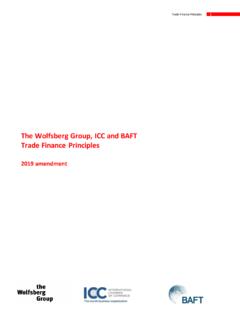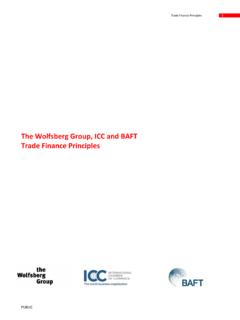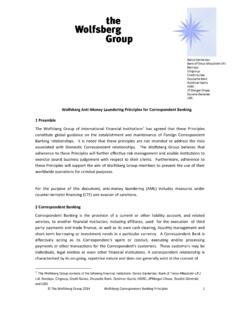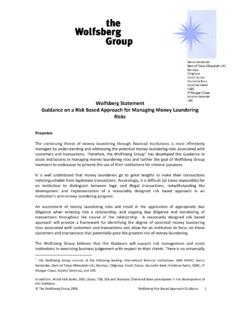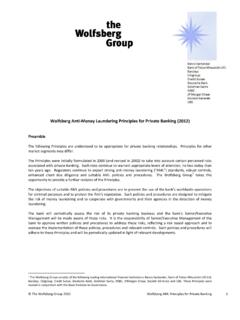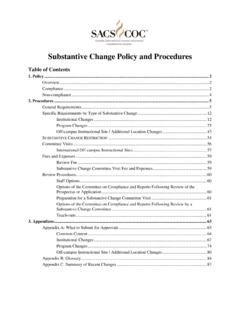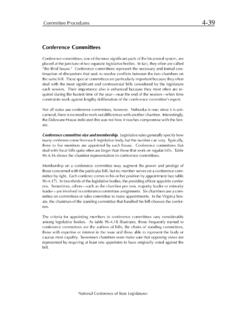Transcription of Wolfsberg Group Payment Transparency Standards
1 The Wolfsberg Group 2017 Payment Transparency Standards 1 Wolfsberg Group Payment Transparency Standards Background The 2007 Wolfsberg Group and Clearing House Association s statement on Payment Message Standards1 was an important intervention to enhance Transparency regarding parties to transactions in international payments. The four Payment message Standards to be observed by all financial institutions (FIs) remain relevant today and are: Financial institutions should not omit, delete or alter information in Payment messages or orders for the purpose of avoiding detection of that information by any other financial institution in the Payment process Financial institutions should not use any particular Payment message for the purpose of avoiding detection of information by any other financial institution in the Payment process Subject to all applicable laws.
2 Financial institutions should cooperate as fully as practicable with other financial institutions in the Payment process when requested to provide information about the parties involved Financial institutions should strongly encourage their correspondent banks to observe these principles Over the last decade the financial services industry has made significant progress in adopting these Standards , such as through the introduction of MT202 COV for cover payments2 by SWIFT; the development of market practice guidelines by various bodies such as the Payments Market Practice Group (PMPG); Enhanced Due Diligence (EDD) arrangements in relation to correspondent banking relationships and the development and deployment of various tools by FIs to enhance the identification of any omission, deletion or alteration of Payment information.
3 The Wolfsberg Group has recently reviewed its Transparency Standards and is publishing additional Standards . These additional Standards are aspirational in nature and the Group notes that full adoption will require investments to be made over time, for example, for FIs to realign policy, data and systems to these new requirements and/or foster the development of enhanced market infrastructures. Legacy payments infrastructures may limit the amount of information that can be included in a Payment due to the absence of sufficient field space. In setting out these additional aspirational Standards , the Wolfsberg Group calls on providers of payments infrastructures and delivery channels, as well as FIs, to continue to address these limitations and coordinate their actions through the adoption of technology and consistent structured formats 1 (2007).
4 Pdf 2 (20-05-09).pdf The Wolfsberg Group 2017 Payment Transparency Standards 2 to provide sufficient system capacity to transmit the volume of information required for increased Transparency . Full adoption of ISO 20022 standards3 would support addressing these limitations. The Wolfsberg Group also welcomes efforts by the public sector to support progress on enhanced Payment Transparency , such as the Basel Committee Guidelines on Due Diligence and Transparency regarding Cover Payment Messages related to Cross-border Wire Transfers 2009;4 Financial Action Task Force (FATF) Recommendation 16;5 FATF Correspondent Banking Guidance 2016;6 Basel Committee Guidelines on Correspondent Banking 20167 and through related regulations.
5 The Wolfsberg Group supports the view of the Bank for International Settlements (BIS) Committee on Payments and Market Infrastructures (CPMI) that enhancing Payment Transparency has a role to play in addressing correspondent banking de-risking. In its 2016 report on Correspondent Banking, the CPMI identified further steps in this regard and made the following recommendation: 8 By June 2017, SWIFT PMPG and the Wolfsberg Group are expected to develop an action plan for strengthening market guidance concerning the use-cases for Payment messages, including (i) what data should be included in Payment messages; (ii) how to include the Legal Entity Identifier (LEI) in Payment messages (on an optional basis) and (iii) where to place the information on beneficiary and originator in the data fields.
6 In response, the Wolfsberg Group is proposing the below additional Standards . The Standards These Standards should apply to: cross-border transactions domestic transactions, to the extent possible with current national Payment infrastructures all currencies all payments regardless of value all participants originating , intermediating or receiving payments unless specifically excluded by FATF Recommendation 169 ( transactions carried out using credit, debit or prepaid cards for the purchase of goods or services). These Standards should additionally be used by parties working on the introduction of new Payment methods and platforms, including for domestic payments, where covered by FATF Recommendation 16. As the payments landscape and supporting technologies continue to develop, the capability to support these Standards will further support enhancements in payments Transparency .
7 Where Payment infrastructures do not provide for transmission of information as mentioned in these Standards , FIs should retain the originator and beneficiary information and have processes in place to make such information available to other relevant parties in the Payment chain on request. 3 ISO 20022 is an ISO standard for electronic data interchange between financial institutions that includes Payment transactions, securities trading and settlement information, credit and debit card transactions and other financial information. More information can be found here: 4 5 6 7 8 9 The Wolfsberg Group 2017 Payment Transparency Standards 3 1. originating FIs The originating FI is responsible for.
8 Verification, identification and due diligence of its customer, as well as related record keeping in line with all the regulations applicable to the FI accuracy and completeness of information in the Payment message concerning the originating party maintaining adequate records that permit the reconstruction of messages if required ensuring that messages contain all required information in compliance with FATF Recommendation 16, as well as any other information stipulated by applicable regulations and guidance ensuring the correct use of Payment messages so as to facilitate identification of Payment information by all FIs in the Payment process and including information on the beneficiary party as described below When originating payments, an FI should: A. Include the following information on the originator as the preferred approach to complying with the requirements of FATF Recommendation 16: Name, Address and Account number of the customer of the FI, who is also the originator of the Payment .
9 In the absence of an account number, a unique transaction reference number or code must be included. Name refers to the name of the customer as verified by the FI. For natural person customers, the name recorded in the FI s systems should be the full name of the customer that was verified as part of Customer Due Diligence (CDD). For accounts held in joint names, the FI should set out in its policy which names are to be recorded on its systems and which of those names should be used for payments. These policies must be in line with all the regulations applicable to the FI. For legal entity customers ( companies, partnerships) multiple names may exist such as registered legal name, trading name, doing business as name or commonly abbreviated name. For example: Registered Legal Name Trade Name/Doing Business As (DBA) Name Eastern Finmark Corporation Finmark or EFC Purpose The name given in the partnership agreement, articles of incorporation or other documents.
10 It is used when communicating with the government or other businesses, when filing tax returns or buying property. The name a business uses for advertising and sales purposes that is different from its legal name. A trade name can also be referred to as a DBA. The FI should place preference on the registered legal entity name verified as part of CDD. The FI should set out in its policy which names are to be recorded on its systems and which of those names should be used for payments. These policies must be in line with all the regulations applicable to the FI. Address refers to an address of the customer as verified by the FI. Address information should be sufficient to identify clearly the location of the party/parties for screening and anti-money laundering (AML) monitoring.
